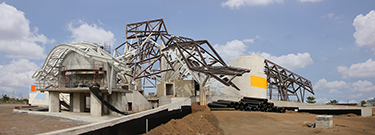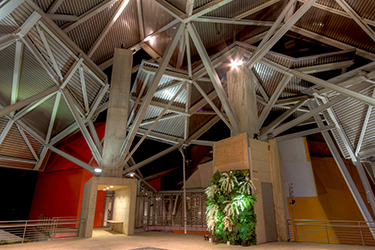|
Subscribe / Renew |
|
|
Contact Us |
|
| ► Subscribe to our Free Weekly Newsletter | |
| home | Welcome, sign in or click here to subscribe. | login |
Architecture & Engineering
| |
 |
January 27, 2014
National finalist: Platinum award
MKA
Project: BioMuseo, Panama City, Panama
Client: Fundacion Amador
Located on the shores at the entrance to the Panama Canal, the BioMuseo announces itself to all incoming ships as they enter Panama.
Fundacion Amador, a private nonprofit foundation representing over 100 local companies, targeted Frank Gehry as its designer from the start of the project. The world-renowned architect delivered a technical marvel that structural engineer MKA was charged with making a reality.
The biodiversity museum features an open design and a roof that echoes the rain forests of Central America. The steel roofs, modeled after the rain forest canopy, are completely asymmetrical.
This design feature requires that the supporting “trunks” also be asymmetrical. Limitations prevented on-site welding, providing the opportunity for MKA to design the structure to be bolted together on site, with welding performed at the fabrication site.
The design required massive steel elements. Steel construction is a rarity in Panama, and MKA went above the contract scope to provide as much technical knowledge transfer as possible. MKA hosted Panamanian structural engineer Oscar Ramirez in Seattle to work side-by-side, exploring and explaining the project’s sophisticated Catia building-information modeling software and MKA’s analysis models.
As Panama’s first 3-D-designed project, the museum demonstrated to the local A/E/C industry the potential opportunities and benefits realized through 3-D design. Local contractors had never worked with 3-D modeling, so MKA facilitated the training of Ingeneria R-M, the Panamanian general contractor and steel contractor, in 3-D software at Gehry’s offices.
MKA and Gehry recommended Portland-based Columbia Wire & Iron Works to meet with local steel fabricator Grupo Nova to evaluate capabilities. CWI spent three months training the Panamanian firm and fabricated the difficult curved steel members (20 percent of the total). The relationships MKA fostered between the project firms established the technical knowledge needed to launch future steel-based construction in Panama.
Tourism and education in Panama will also benefit from the BioMuseo, which is expected to attract 1.89 million foreign visitors in five years.
Public education programs will enable 40,000 school children to tour the facility and gain valuable knowledge on the diversity in their backyard. The BioMuseo has eight galleries and features twin 40-foot-tall aquariums — one featuring Atlantic sea life, the other Pacific sea life — that show how life evolved separately following the creation of the Isthmus of Panama millions of years ago.
The economic boost to Panama from the BioMuseo is expected to be no less significant than the projected attendance. The overall economic impact of $6.7 million per year, and the addition of more than 10,000 jobs in tourism-related industries, will have a significant impact on lives in Panama. In the first five years of operation, Panama will receive $46 million in direct revenue.
Other Stories:
- National finalist: Gold award
Special projects - Best in State: Gold award
Originality/innovation - Best in State: Gold award
Owner/client needs - Best in State: Gold award
Future value to engineering profession - Best in State: Gold award
Complexity - National finalist: Gold award
Structural systems - National finalist: Gold award
Environmental - National finalist: Gold award
Energy - National finalist: Gold award
Structural systems - Best in State: Gold award
Social/economic sustainability




